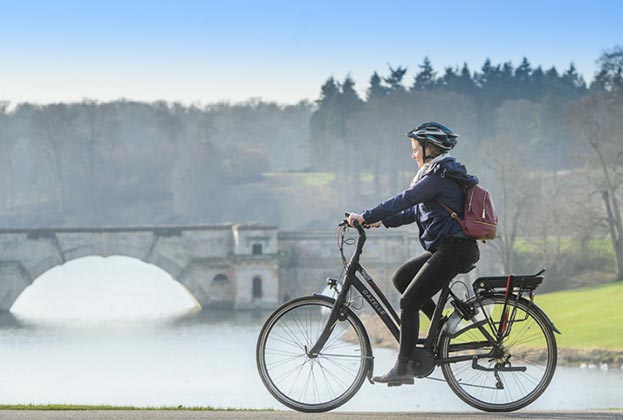To meet the government’s net zero target, it is essential that rural businesses measure their carbon footprint and lead the way in reducing their GHG emissions
An overhaul of the UK’s rural economy will be essential to meet the government’s net zero target. To remain viable, rural businesses must change the way they operate and become leading examples for reducing the sector’s domestic greenhouse gas emissions.
For the government’s net zero target to remain viable, rural businesses must change the way they operate
Nicola Buckingham, Associate Director, Rural Research
Decarbonisation starts with understanding your carbon footprint. The Greenhouse Gas Protocol (GHGP), see below, is a tool for rural estates to do just that. Much of an estate’s carbon footprint is determined by land use and livestock numbers. However, diversified businesses will have their own range of impacts – from cleaning products to staff transport. The GHGP can be used to measure the carbon footprint of an estate’s diversified operations as well as its core land use.
The Greenhouse Gas Protocol
This is a globally recognised standard for measuring and managing Greenhouse Gas emissions from companies and their value chains. It classifies emissions in three scopes:
By measuring Scope 3 emissions businesses can assess where the emission hotspots are in their supply chain and identify opportunities to significantly reduce their carbon footprint and often costs at the same time. The major Scope 3 emission sources for tourism are:
- purchased goods and services: primarily food and drink;
- travel: primarily transportation to and from the destination.
Taking responsibility for travel
Scope 1 and Scope 2 emissions are by their very nature easier to measure and influence than Scope 3 emissions. Energy provision in accommodation is an obvious example. Many accommodation types rely on heating and air conditioning to keep guest rooms at a pleasant temperature. Other energy-intensive devices, such as water heaters for showers and pools, lights, TVs, refrigerators and laundry machines, all contribute to Scope 1 and Scope 2 emissions. Switching to renewable energy sources and energy-efficient equipment are simple and cost-effective wins.
Minimal, partial, or significant influence
For many tourism providers, much of their Scope 3 footprint is out of their direct control. Consequently, there is only so much they can do to reduce these emissions, such as encouraging customers to use low carbon transport. To account for this, an attribution strategy can be developed. A full carbon footprint (Scopes 1, 2 and 3) will quantify the amount of emissions that arise from running a destination attraction and an attribution strategy can complement this by determining how much influence the business has over each aspect of the footprint. To undertake this process, two key steps need to be taken:
- Materiality assessment: How important is each component of the footprint? How much does each aspect of the footprint vary?
- Influence mapping: How much influence do we have over each aspect of the footprint? Significant? Partial? Or minimal?
This is a complex assessment and only the highest profile or most regulated businesses are likely to need to justify their attribution strategies. But lessons can be learned as to how these high-profile businesses are responding to the Scope 3 challenge.
Responding to the challenge
Travel is the final piece in the carbon emissions reduction puzzle
The heritage landscape of the UK provides major commercial value to the tourism economy. According to the Centre for Economics and Business Research (CEBR), heritage-related visits and trips in England alone totalled £215m in 2019.
The largest of these heritage businesses have been at the vanguard of adopting meaningful approaches to both understanding and improving overall environmental and social impact. However, all tourism businesses rely on travel, as visitors come to them as destinations.
Taking responsibility for this travel impact is the final piece of the puzzle in reducing carbon emissions, but sustainable travel is now also a major issue in making visitor destinations affordable and accessible to as many people as possible. We look here at how some of the UK’s greatest estates are responding to the sustainable travel challenge.
Positive action
In collaboration with Historic Houses, Savills surveyed some of the UK’s most popular heritage destinations, each with over 50,000 annual visitors. The focus of our survey was sustainable transport, but many of the conversations with participants touched on sustainability being a core element of future business strategy across all parts of the business.
Participants who identified themselves as “not doing very much” for sustainability or being in the preliminary stages of developing a sustainability strategy had still implemented several “quick wins”.
The table below highlights short, medium and long-term actions that are already in place or are being considered by our respondents.
Sharing best practice
There are many lessons to be learned from the experiences of these estates in adopting sustainable transport options for visitors.
The majority of these estates were actively promoting their sustainability strategies, and most of them had begun to tackle the sustainable transport challenge.
Understandably, the biggest barriers related to the investment that is needed in grid infrastructure to enable electrification, and in public transport networks to provide connectivity to urban populations (see Sustainable tourism, below). Although local, regional, and national tourism initiatives are seen as an important mechanism to promote sustainable tourism to the public and help towards alleviating some of the barriers, the government needs to do much more, much quicker to invest in these core services as part of its net zero investment plans. For remote destinations dependent on road access, rural tourism and leisure operators may feel they have little choice until this happens. However, our survey showed how creative sustainability thinking can produce a win-win for visitors and destinations alike, with cycling being one example of a low-cost, high-experiential sustainability initiative to champion.
Sustainable tourism
Of the UK destinations surveyed by Savills in collaboration with Historic Houses:
Read the articles within Spotlight: Rural Tourism and Leisure below.
.jpg)
